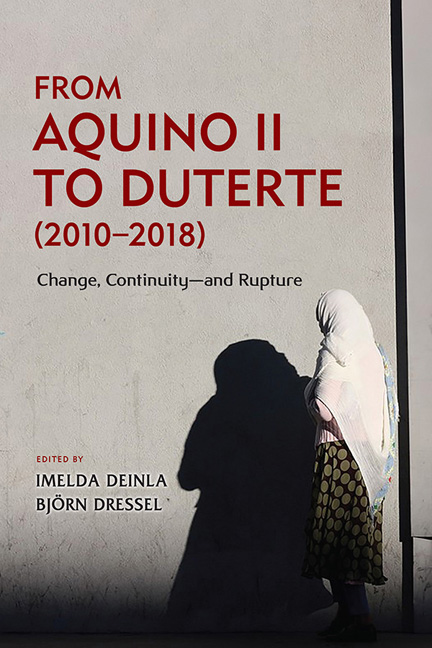Book contents
- Frontmatter
- Contents
- List of Tables
- List of Figures
- Acknowledgements
- Acronyms and Glossary
- Contributors
- Introduction: From Aquino II to Duterte (2010–2018): Change, Continuity—and Rupture 1
- PART I POLITICS AND GOVERNANCE
- PART II ECONOMIC GOVERNANCE
- 4 How Has the Economy Fared under the Duterte Administration So Far?
- 5 The Philippine Economy: Renewed Dynamism, Old Challenges
- 6 Competition Law and Policy in the Philippines: A Role in Sustained and Inclusive Economic Growth
- PART III PEACE PROCESS IN MINDANAO
- PART IV INTERNATIONAL ENVIRONMENT
- Index
4 - How Has the Economy Fared under the Duterte Administration So Far?
from PART II - ECONOMIC GOVERNANCE
Published online by Cambridge University Press: 31 January 2020
- Frontmatter
- Contents
- List of Tables
- List of Figures
- Acknowledgements
- Acronyms and Glossary
- Contributors
- Introduction: From Aquino II to Duterte (2010–2018): Change, Continuity—and Rupture 1
- PART I POLITICS AND GOVERNANCE
- PART II ECONOMIC GOVERNANCE
- 4 How Has the Economy Fared under the Duterte Administration So Far?
- 5 The Philippine Economy: Renewed Dynamism, Old Challenges
- 6 Competition Law and Policy in the Philippines: A Role in Sustained and Inclusive Economic Growth
- PART III PEACE PROCESS IN MINDANAO
- PART IV INTERNATIONAL ENVIRONMENT
- Index
Summary
INTRODUCTION
President Duterte inherited an economy from the Aquino administration that had grown at a yearly average rate of 6.2 per cent over the previous five years—the highest average rate of growth the economy had achieved since the 1970s. By end 2016, the economy had had seventy-one quarters of positive growth, which was remarkable in that it occurred against the backdrop of the Global Financial Crisis in 2008–9. Fiscal and monetary policies were responsibly conducted, increased spending occurred while fiscal space was also being created so the country managed to achieve investment-grade status after a long time of being below this. Inflation was under 2 per cent, well within the Bangko Sentral ng Pilipinas (BSP)'s target of 2–4 per cent.
Under President Duterte's watch, growth continued and the economy expanded by 6.6 per cent in the fourth quarter of 2016. Although this was the slowest quarterly growth rate in 2016, it was higher than the 6.3 per cent in the same quarter in 2015. According to Director General Ernesto Pernia of the National Economic and Development Authority (NEDA), “For the full year of 2016, we are so far the fastest growing economy with China at 6.7 per cent and Vietnam's 6.7 per cent”.
Nevertheless, it is clear that daunting challenges remain. Despite growth, poverty remains a long-standing and pervasive problem. By the end of the Aquino administration in 2016, poverty incidence did decline —to 21.6 per cent—from about 25 per cent over several decades.
There is no denying the economy needs to grow robustly in order to significantly reduce poverty. The greater challenge is how to make growth more inclusive and reduce poverty and income inequality. NEDA Director General Pernia has stated “the target of 6.5–7.5 per cent growth for 2017 is highly likely” to be achieved. In the medium term, we expect growth to strengthen further towards 7 or 8 per cent, with the economy expanding by about 50 per cent in real terms and per capita income rising by over 40 per cent over the next six years”. These growth rates would put the Philippines in the upper-middle income category by 2022 and reduce poverty incidence from 21.6 per cent to 14 per cent—lifting about 6 million Filipinos out of poverty
- Type
- Chapter
- Information
- From Aquino II to Duterte (2010–2018)Change, Continuity—and Rupture, pp. 127 - 144Publisher: ISEAS–Yusof Ishak InstitutePrint publication year: 2019



